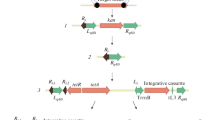Abstract
Xanthobacter Py2 grows on propene as sole carbon source, converting propene to propene oxide (epoxypropane) using an alkene-specific monooxygenase, as the first step in catabolism. Four mutants, NZ1–4, with a propene− propene oxide+ phenotype were isolated by 1-methyl-3-nitro-1-nitrosoguanidine mutagenesis or by enrichment with the suicide substrate vinylidene chloride, and were shown to have lost the ability to convert alkenes to epoxides. All four mutants were complemented by a number of clones of Xanthobacter Py2 chromosomal DNA in the broad-host-range cosmid pLAFR5, some of which appeared to be non-overlapping. Representatives of the different clones obtained were transferred into Xanthobacter autotrophicus JW33 and one, pNY2, the most frequently isolated clone, was shown to express an inducible, fully functional propene monooxygenase. Subcloning revealed that all four mutants were complemented by a 2.4-kb EcoRI-PstI fragment situated at one end of the cosmid insert. However, activity in X. autotrophicus JW33 could only be expressed from pNY2, containing the complete insert (25 kb), suggesting a large operon or some form of long-range control. pNY2 failed to express in E. coli. In X. autotrophicus JW33 [pNY2] at least three new polypeptides were evident after induction with propene compared with a control carrying only the cosmid pLAFR5.
Similar content being viewed by others
References
Bont JAM de (1993) Biotransformation of optically pure epoxides. Tetrahedron Asymm 4: 1331–1340
Bont JAM de, Attwood MM, Primrose SB, Harder W (1979) Epoxidation of short chain alkenes in Mycobacterium E20: the involvement of a specific monooxygenase. FEMS Microbiol Lett 6: 183–188
Boyer HC, Roulland-Dussoix D (1969) A complementation of analysis of the restriction and modification of DNA in E. coli. J Mol Biol 41: 459–472
Clarke L, Carbon J (1976) A colony bank containing synthetic Col E1 hybrid plasmids representative of the entire E. coli genome. Cell 9: 91–99
Dalton H (1992) Methane oxidation by methanotrophs: physiological and mechanistic implications. In: Murrell JC, Dalton H (eds) Methane and methanol utilisers. Biotechnology handbooks vol 5. Plenum, New York, pp 85–114
Ferretti L, Sgaramella V (1981) Specific and reversible inhibition of the blunt end joining activity of the T4 DNA ligase. Nucleic Acids Res 9: 3695–3705
Figurski DH, Helinski DR (1979) Replication of an origin-containing derivative of plasmid RK2 dependent on a plasmid function provided in trans. Proc Natl Acad Sci USA 76: 1648–1652
Fulton GL, Nunn DN, Lidstrom ME (1984) Molecular cloning of a malyl coenzyme alyase gene from Pseudomonas sp. strains AM1, a facultative methylotroph. J Bacteriol 11: 718–723
Furuhashi K (1992) Biological routes to optically active epoxides. In: Collins AN, Sheldrake GN, Crosby J (eds) Chirality in industry. Wiley, Chichester, pp 167–186
Ginkel CG van, Bont JAM de (1986) Isolation and characterization of alkene-utilizing Xanthobacter spp. Arch Microbiol 145: 403–407
Ginkel CG van, Welten HGJ, Bont JAM de (1987) Oxidation of gaseous and volatile hydrocarbons by selected alkene-utilizing bacteria, Appl Environ Microbiol 53: 2903–2907
Hanahan D (1985) Techniques of transformation of E. coli In: Glover D (ed) DNA cloning, vol 1. IRL, Oxford, pp 109–135
Hartmans S, Somhorst BPM, Voskuilen CTH, Bont JAM de (1988) Poster presented at NBC-2, Amsterdam
Hartmans S, Kaptein A, Tramper J, Bont JAM de (1992) Characterisation of a Mycobacterium sp. and a Xanthobacter sp. for the removal of vinyl chloride and 1,2-dichloroethene from waste gases. Appl Microbiol Biotechnol 37: 796–801
Keen NT, Tamaki S, Kobayashi D, Trollinger D (1988) Improved broad-host-range plasmids for DNA cloning in gram-negative bacteria. Gene 70: 191–197
Leak DJ, Aikens PJ, Seyed-Mahmoudian M (1992) The microbial production of epoxides. Tronds Biotechnol 10: 256–261
Lowry OH, Rosebrough NJ, Farr AL, Randall RJ (1951) Protein measurement with the Folin phenol reagent. J Biol Chem 193: 265–275
Miller RH (1972) Experiments in molecular genetics. Cold Spring Harbor Laboratory, Cold Spring Harbor, NY, pp 125–129
Sambrook J, Fritsch EL, Maniatis T (1989) Molecular cloning,a laboratory manual. Cold Spring Harbor Laboratory, Cold Spring Harbor, NY
Swaving J, Weijers CAGM, Ooyen AJJ van, Bont JAM de (1995) Complementation of Xanthobacter Py2 mutants defective in epoxyalkane degradation; expression and nucleotide sequence of the complementing DNA fragment. J Gen Microbiol (in press)
Walsh CT, Chen Y-CJ (1988) Enzymic Bayer-Villiger oxidations by flavin dependent monooxygenases. Angew Chem Int Ed Engl 27: 333–343
Weber FJ, Berkel WJH van, Hartmans S, Bont JAM de (1992) Purification and properties of the NADH-reductase component of alkene monooxygenase from Mycobacterium strain E3. J Bacteriol 174: 3275–3281
Weijers CAGM, Haan A de, Bont JAM de (1988) Chiral resolution of 2,3-epoxyalkanes by Xanthobacter Py2. Appl Microbiol Biotechnol 27: 337–340
Whittenbury R, Phillips KC, Wilkinson JF (1970). Enrichment, isolation and some properties of methane utilizing bacteria. J Gen Microbiol 61: 205–218
Wiegel J, Wilke D, Baumgarten J, Opitz R, Schlegel HG (1978) Transfer of the nitrogen fixing hydrogen bacterium Corynebacterium autotrophicum Baumgarten et al. to Xanthobacter gen. nov. Int J Syst Bacteriol 28: 573–581
Author information
Authors and Affiliations
Rights and permissions
About this article
Cite this article
Zhou, NY., Chan Kwo Chion, C.K. & Leak, D.J. Cloning and expression of the genes encoding the propene monooxygenase from Xanthobacter, Py2. Appl Microbiol Biotechnol 44, 582–588 (1996). https://doi.org/10.1007/BF00172489
Received:
Revised:
Accepted:
Issue Date:
DOI: https://doi.org/10.1007/BF00172489




